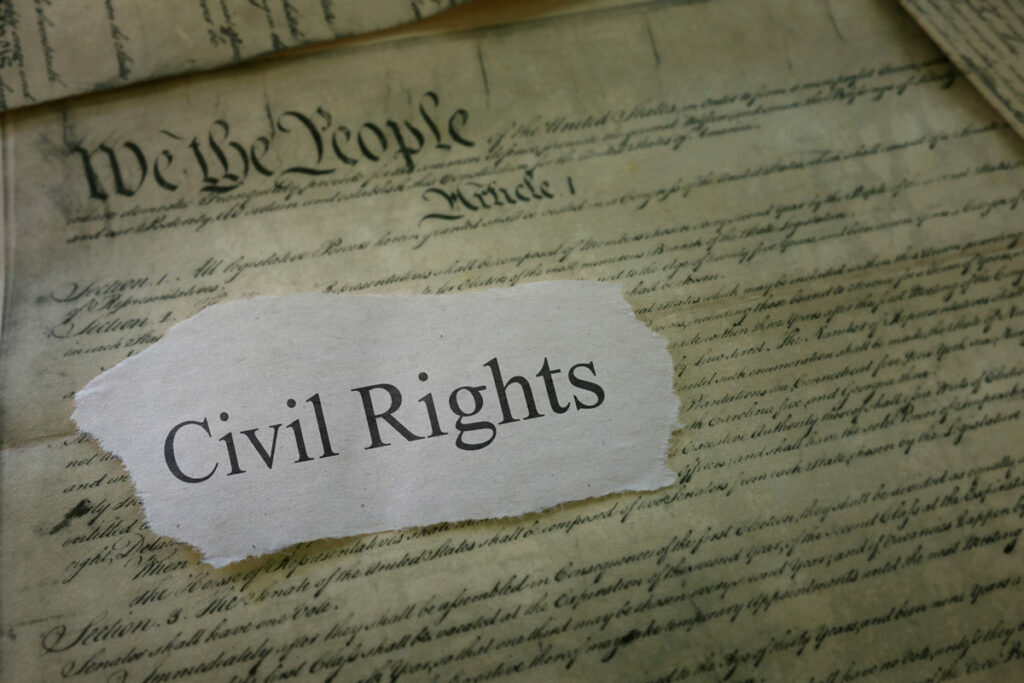Civil Rights Litigation: Why It Matters

Civil rights litigation plays three indispensable roles in the ongoing pursuit of a better, more just and equal society: first, it presents a way to overcome injustice where legislation lags; second, it informs the process of passing meaningful legislation to reform the policies and social norms that deprive Americans of their civil rights; and third, it provides a civil means of ensuring that powerful organizations follow the laws once they are on the books.
In 1976, Abram Chayes introduced a radical new concept in civil law—the idea that the victims of systemic injustice could create change through “public law litigation.” Before that, civil law was largely limited to moderating conflicts between two parties, but Chayes argued that those whose civil rights had been violated through social or institutional injustice could sue for systemic change. Since then, civil rights litigation has been able to succeed even where the law is vague, driving significant reform ranging from the end of orchestrated school prayer to the dismantling of legal apartheid.
Beyond winning victories in court, civil rights litigation also clarifies the nature of injustice, raises awareness among politicians and the public, and helps to inform the legislative process. This is an essential part of the American system: the United States Constitution gives the judicial broad power to “check and balance” the legislative and executive branches. And in dozens of landmark cases, such as Brown v. Board of Education and Miranda v. Arizona, civil litigation has led to better laws and a fairer system.
Finally, most civil rights laws are civil in nature. Anti-discrimination laws, for example, create a standard by which a plaintiff can sue for damages, but they do not impose criminal penalties for those who violate them. (That is, an employee who loses out on a promotion because of her race can sue for the wages she lost through discrimination, but her manager won’t face criminal charges.) That leaves civil rights litigation as the primary means for enforcing those laws. From the swath of lawsuits challenging police departments’ use-of-force guidelines to litigation protecting women of color from potentially cancerous talcum powder, civil rights litigators ensure that those who violate civil rights laws pay a price.
However, systemic violations of civil rights are often nuanced, making civil rights cases challenging. If your civil rights have been violated, working with a qualified lawyer to assess your potential suit and the damages you may be able to recover is an essential first step.
Why We Are a National Litigation Firm

For the partners at Napoli Shkolnik, living and working within New York State, without maintaining a nationwide presence, would certainly provide plenty of work. This is a global business and financial center with a statewide population of 19.5 million, and if it were a nation New York would have the 10th largest economy in the world. The issues causing the most harm in the United States – civil rights violations, medical and product safety issues, and the opioid crisis – aren’t contained to any particular state. They’re nationwide problems, and it requires a nationwide firm to represent victims effectively.
Taking this stance has given us the opportunity to bring our expertise and spirit to important cases inside and outside New York, like representing the citizens of Flynt, MI, after the city switched to a cheaper water source, even though they knew it would be toxic, or representing county and city governments struggling with the resource-drain of widespread opioid addiction. We’ve also been able to represent clients across the country in products liability suits and civil rights litigation—such as suing Johnson & Johnson for racially motivated marketing of dangerous talcum products.
Having a nationwide footprint also gives us the strength to take on formidable opponents. That’s been the case in opioid litigation: pharmaceutical companies, with their endless resources, fight a war of attrition in the courts, and without a deep bench of personnel and the ability to work concurrently in different jurisdictions, we’d have a hard time winning for our clients. It’s also been true in the many cases where we’ve fought for plaintiffs who have no money for lawyers. Those are the ones that matter the most to us, and it’s our nationwide reach that’s allowed us to notch victories.
In many cases, being a nationwide firm has also allowed us to bring the power and profile of a New York law firm to cases that might not otherwise get the attention or legal expertise we can provide. That’s true of environmental law cases in less developed states; it’s true of our practice in Puerto Rico; and it’s been true of numerous products liability cases over the years. Our access to expert witnesses and legal scholars who can bolster our theories has helped us win large settlements—and more importantly deliver much-needed relief to victims.
Finally, a nationwide footprint gives us an opportunity to learn about cases we otherwise might not. We pride ourselves on our lawyers’ ability to assess the viability of a case and lay out options for a plaintiff, often in the first conversation they have. And when those conversations reveal significant harms, we pride ourselves even more on our ability to deliver meaningful results.
Lead Poisoning Remains a Health Threat to Children

Lead has been a known toxin for decades: it was banned from paint in 1978 and from gasoline in 1996. However, lead still has numerous commercial uses, including in car batteries, pigments, ammunition, weights, and radiation protection—and in pipes used to carry drinking water. That can lead to significant harm from industrial pollution; and with between 9.7 million and 12.8 million pipes containing lead in the US, lead poisoning from the water supply is still a very real concern.
Probably the most well-known example of widespread lead poisoning in recent years occurred in Flint, MI, where the city opted to draw its water from a polluted river instead of the Detroit water utility, sending toxic water into the city’s homes. After the crisis garnered widespread media attention, investigations lead to criminal indictments of municipal and state employees, and a lawsuit ended in a settlement of over $600 million.
But Flint is hardly the only example. In Benton Harbor, MI, another majority-black municipality, widespread lead poisoning came from the water pipes still used by the city—and was only discovered in 2018 after the Rev. Edward Pinkney noticed discoloration in residents’ water and raised the alarm. Even now, four years later, the city is just beginning to award contracts to replace the pipes, and residents are relying on bottled water brought in by volunteers from Indiana.
Lead also poses an occupational risk, especially for workers at smelters such as the Gopher Resources facility in Tampa, FL, where lead-laced dust has poisoned hundreds of employees. Even though the risk of lead poisoning was well known, workers were not provided adequate protective gear—or, in many cases, even told that the dust blowing through the factory contained lead.
The effects of lead poisoning are most acute in children, who can experience behavior and learning problems, lower IQ, hyperactivity, slowed growth, hearing problems, and anemia. Lead can also accumulate in the body over time, posing a risk to unborn children whose mothers are exposed before or during their pregnancy. In adults, lead poisoning can have cardiovascular effects, such as increased blood pressure and hypertension; it can decrease kidney function; and it can create reproductive problems.
While local, state, and federal governments are mostly committed to protecting the population from lead poisoning, history tells us that real remediation only happens when media attention and lawsuits put pressure on authorities to act. If you have been exposed to lead at work, in your drinking water, or as a result of industrial pollution, you should consult a qualified attorney to pursue relief for yourself and others who may be experiencing the same effects.
The Importance of Environmental Law to American Citizens

In the 1970s, the United States passed three major pieces of legislation which, together, make up the foundation of American environmental law: the Clean Air Act, the Clean Water Act, and the Toxic Substances Control Act. The urgency to pass all of these acts stemmed from the fact that building at a massive scale and industrial production had wreaked havoc on the environment—with disastrous implications for public health and the future. At its most basic level, the practice of Environmental Law involves protecting the American people from the environmental impacts these and other subsequent laws were enacted to prevent.
One of the challenges of effective environmental policy in the United States is the means of enforcement. Environmental laws are enforced by agencies (such as the Environmental Protection Agency), which have broad powers to study and investigate environmental impacts and punish those responsible, but which are not always able to exercise those powers effectively.
The problem is that those powers—and the policies the EPA and other agencies pursue—are often limited by politics, by funding and staff levels, and by a philosophy of encouraging companies to remediate environmental damage over time rather than slapping them with crippling punishments. That means that many cases of severe pollution go undiscovered, sometimes for decades. In a recent Propublica series, for example, investigative reporters looked at air and water pollution in the American Southeast and discovered that in rural parts of the country polluters routinely violate emissions standards and their regulations with little or no penalty.
That’s where environmental lawyers come in. If you’ve been impacted by toxins or pollutants in your environment, calling the EPA is a reasonable first step. But it’s not one that’s likely to lead to a speedy resolution, relief for the damages you’ve experienced, or meaningful change. That comes through environmental lawyers bringing legal action against the individuals, companies, and even government agencies that adversely impact the air, water, and land we all share.